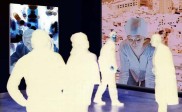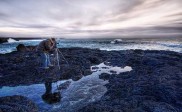Food Photography: Tips for Taking Mouthwatering Food Photos
May be you didn’t notice it, but food photography constitutes a big part of our everyday life. Recipe books, culinary magazines, posters and food ads… You nearly can’t spend a day without viewing a photo of some sort of food. Succeeding in food photography isn’t a given thing. Professional food photographers often use surprising ways to get the best results possible. Along with top-notch gear and lighting, they also use coloring substances, varnish, and even glue in some cases.
Still, you can get decent results without having to ruin your meal. This article will provide you with some tips and techniques for photographing your food while being able to savor it afterwards.
When photographing food you need to take the shot in a way that will make the viewer want to taste it. For this, you must master your composition and lighting, but you need also to study and discover the characteristics of the food you are photographing.
Frankartculinary
Presentation:
Along with his/her photography skills, a food photographer needs to have skills in food presentation and display. Just like a human model, food will look better in photos, if placed in the appropriate setting, and made nicer through some garnish. So, you need to find the best way to present the food you are photographing through studying it and determining its most dominant features.
Opt for simple and neutral table wear, in order to avoid any distraction from your main subject. White dishes and a simple white table cloth should do the trick. Also, don’t forget to use garnish to add some contrast to your dishes. For example if you are photographing a dish of a yellowish sauce try to add a bit of green herbs on top of the dish to make it stand out. You can use raw materials along with the food you are photographing, to help the viewer understand the constituents of the dish. For instance, you can photograph a pot of strawberry jelly, with a basket of strawberries. Try to inspect your subject to find the detail which defines it and makes it special, and try to emphasize that detail. It can be the texture of a vegetable, the color of a fruit or the smoke coming out from grilled food. Depending on the subject in question, you need to find that special feature and to make it obvious to the viewer.
Lighting:
Assuming that you don’t own professional lighting equipment, the best option available to you in that case is natural light. Put a table near a window and use the light coming through it to your advantage. It will provide you with just what you need. Avoid taking photos under direct sunlight though, as it will produce harsh shadows which will hide the details you are aiming to capture. If you have to take photos under direct sunlight, at least, try to use a white cloth to diffuse the light and to get less cast shadows.
If you can’t make use of natural light and you have to use artificial lighting instead, avoid using the camera’s built-in flash and use instead diffused or reflected artificial light ,not directly hitting the food you are shooting. One easy way to light the food you are photographing is to use a home made light box. Grab a carton box, cut out its sides and cover them with translucent paper. Then, put your subject inside the box and point a desk lamp through the translucent material. You will be able to get impressive shots through such a simple device.
Finally, don’t forget, when using artificial lighting, to properly set your white balance. Most cameras have a feature which allows you to pre-set white balance using a white surface under the light you are using.
Composition:
The classic way to shoot food is at a 45° angle from the top of the subject. But, since you will be most probably shooting digital, don’t limit yourself to one perspective and try different points of view. Experiment; shoot many frames and select later. Try to capture some close-ups and details along with the general shots. You can combine different shots afterwards in editing to create a diptych or a triptych which can be much more interesting than a single shot. When composing, try to exclude anything not relevant to the shot from the frame. The less secondary elements there are, the more importance you will give to your main subject. When shooting food which is in a plate try to avoid the “bird’s eye view” point of view, as it will give you a dull and boring shot. Try, instead to take the shot at the level of the table, which will give the dish you are shooting more emphasis and will make it more attractive to the viewer. Also, if you are shooting many items in a single frame try to arrange them in a way which will please the eye. Make use of the rule of thirds to place the different elements of your composition at the intersection of the lines dividing the frame into thirds. Most cameras have the ability to display grid lines that can help you master the rule of thirds.
Some final Thoughts:
-Use tripod: A tripod can be very useful for food photography, especially if you don’t have powerful light sources which will lead you to use long shutter speeds.
– Editing: Editing your shots can help you get perfect results. Simple post processing such as adding contrast and correcting color balance can be all you need.
-Don’t forget to eat the food: There is nothing like a good meal after a long shooting session.
-You may have noticed that I didn’t mention anything about cameras and lenses in the article. That’s because I think that in food photography (as well as in other types of photography), the most crucial things are composition, lighting and understanding the subject. Master these elements and you will be able to produce amazing pictures regardless of the camera you are using.













Thanks